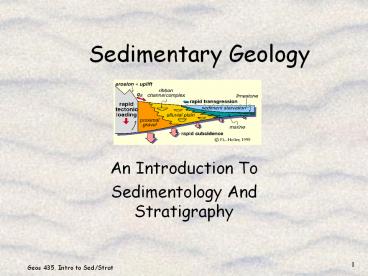Sedimentary Geology - PowerPoint PPT Presentation
1 / 19
Title:
Sedimentary Geology
Description:
Sedimentary Geology An Introduction To Sedimentology And Stratigraphy * * Sedimentary Geology Sedimentology: Processes that erode, transport, and deposit sediments ... – PowerPoint PPT presentation
Number of Views:1552
Avg rating:3.0/5.0
Title: Sedimentary Geology
1
Sedimentary Geology
- An Introduction To
- Sedimentology And Stratigraphy
2
Sedimentary Geology
- Sedimentology
- Processes that erode, transport, and deposit
sediments - Surface environments of sediment accumulation
- Genesis of sedimentary strata
- Sedimentary Petrology
- Physical and mineralogical properties and origin
of sediments and sedimentary rocks (SEDS) - Stratigraphy
- Distribution, origin, and description of
sedimentary strata in space and time
3
Relevance of Sedimentary Geology
- 75 of the Earth's Surface materials consists
of SEDS (sedimentary earth materials) - SEDS contain the majority of Earth Resources
- Oil, Natural gas, fossils fuels
- minerals
- water
- building materials
- Subsurface fluid storage
4
Earth History
- Largely based on the SED Record
- Climate/atmospheric dynamics through time
- Paleoceanography
- Plate tectonics and crustal dynamics
- History of Life
5
Environmental/Natural Hazards
- An understanding of Earth Surface Processes and
Materials is fundamental to - Slope Stability Landslide and catastrophic slope
failure - Fluvial processes river basin flood hazards
- Coastal Change erosion/flooding hazards coastal
land loss - Ground water resources contamination/remediation
6
Sedimentary Geology is Fun!
- We see SEDS and sedimentary environments all
around us - We observe and hear about exciting surface
processes almost every day, - We are all interested in the past and future
evolution of the Earth, especially the Earths
Surface Environments (cuz we are Geoscientists!)
7
Social Relevance of Sedimentary Geology
- Chat with one or 2 other students and list five
important issues of our time - Lets see how sedimentary geology might address
these issues
8
History of Sedimentary Geology
9
Sedimentary Geology is a "synthesis course"
- It depends on other geology courses and other
science disciplines - Physics fluid dynamics, petrophysics, plate
tectonics - Chemistry weathering, chemical sediments,
diagenesis, sedimentary petrology - Biology paleoecology, sedimentary environments,
the fossil record
10
Sedimentary Geology provides the framework for
most other Geosciences disciplines
- Structural Analysis Studies requires an
understanding of initial sedimentary and
stratigraphic context prior to deformation, etc. - Geochemical Studies require a stratigraphic and
petrological context - Hydrogeological Studies depend on an
understanding of the hydrogeological matrix"
both macro- and micro-scale - Geophysical Studies built on a stratigraphic
context and requires "ground truth" based on a
reasonable sedimentologic and stratigraphic
framework.
11
Sedimentary Geology is the Study of
- Sedimentary Processes and Stratigraphic Products
- (Process - Response Models)
- Sedimentary Facies
- A sedimentary facies--gt descriptive aspect of a
rock stratigraphic unit including - lithology, sedimentary structures, geometry,
fossils, etc - Sedimentary-Depositional Environments
- Limited areas of the Earths surface where
sediment accumulates, from mountain top to deep
sea, with distinctive physical, chemical, and
biological processes. - Paleogeography
- Determined from the stratigraphic record of
sedimentary facies and the time/space
distribution of sedimentary-depositional
environments
12
Paleogeography and Earth History
- The time and space mosaic of sedimentary-depositio
nal environments reflecting the evolution of - Tectonic,
- Climatic,
- Biologic, and
- Eustatic (sea level)
- Dynamics through time,
- either on a relative (geological) or
- absolute (radiometric) time frame
13
Sedimentary Geology
- Provides methodology and a theoretical basis to
understand - Stratigraphic relationships
- relative age, geometry, physical/spatial
relationship of strata - Provenance
- sediment source, location, type, etc
- Depositional setting, sediment dispersal
patterns, and transport mechanisms - sedimentary processes
- Paleogeography
- physical geography during deposition
- Tectonic setting
- Plate tectonic setting during deposition
- Diagenesis
- modifications to sediment during burial and the
conditions (temperature, timing, fluid flow
regime) responsible for those changes
14
Using the Principles of Sedimentary Geology
- We can make useful interpretations and
predictions about - Relationships that are not available for
observation (hidden from view) - Spatial distribution, properties, and geometry of
stratigraphic units and resources that are not
exposed/have not been sampled - Relationships that are not preserved in the
geological record - Geological terranes eroded or tectonically
removed - Earth processes that have not yet occurred
- Environmental hazards such as coastal change,
flood hazards, landslides, etc
15
Class Attendance and Engagement
- The emphasis in this class is on application,
analysis, synthesis, and evaluation of our topic
material (higher order thinking skills) - active learning strategies (in the class room)
- move beyond passive participation in the learning
experience (sitting and listening to me) - aggressively think about what you are learning
- hard, time consuming work
16
Class Attendance and Engagement
- Active learning strategy in the class room
requires some prior knowledge and comprehension
of topic material in preparation for class
discussions - mastery of basic facts and vocabulary
- Book and Power Point Presentations
- use class time efficiently and effectively for
the development of higher level intellectual
skills
17
Class Attendance and Engagement
- Inquiry-based portion of class meetings
- a collaborative learning format
- Small groups (2-3) of students working together
to process knowledge and reach conclusions to
questions through thinking and discussion amongst
the collaborative group - In class group accountability
18
Class Attendance and Engagement
- In-class group accountability.
- Each group member is accountable for the
information/conclusions reached by the group in
class. - A group member will be selected by me to present
group consensus conclusions in class. - The evaluation of the group is dependant on the
individuals presentation which will assess the
effectiveness of group comprehension
19
(No Transcript)































